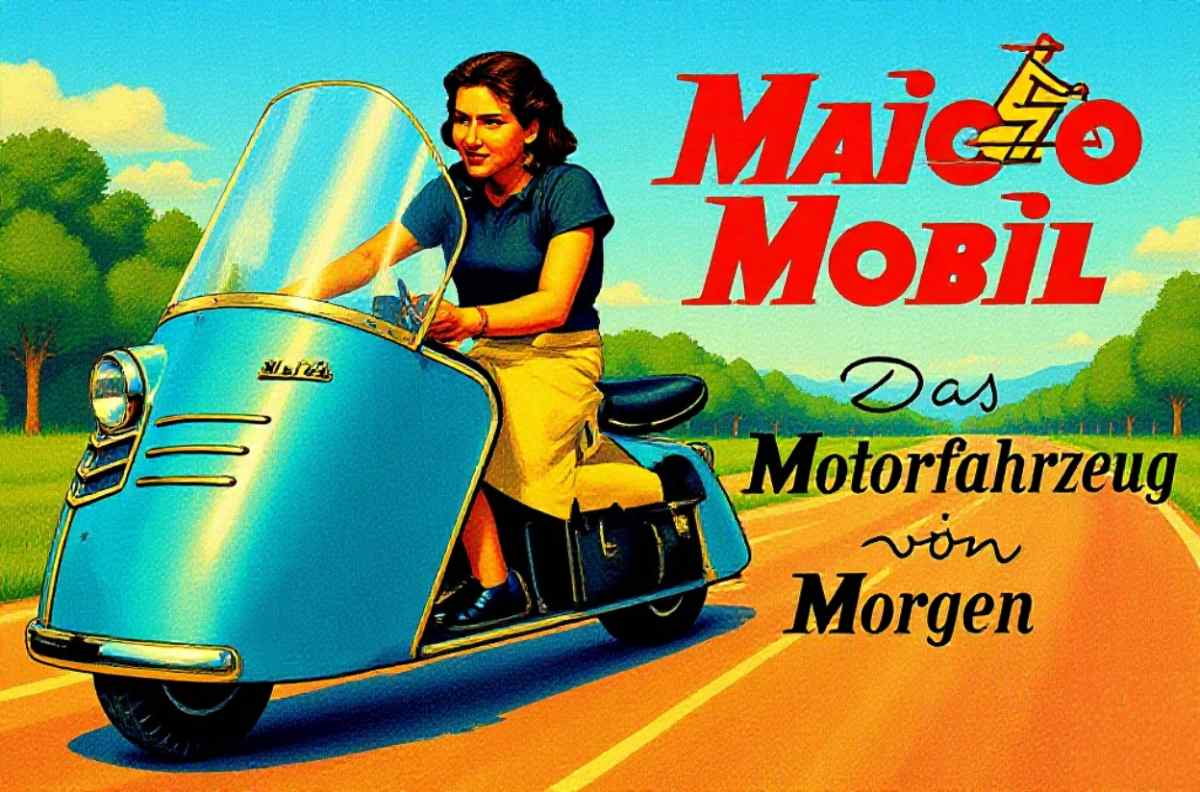- Posted on
- • History
Maico Mobil: Germany's Enclosed "Dustbin" Scooter That Rode Like a Motorcycle
- Author
-
-

- User
- Torque
- Posts by this author
- Posts by this author
-

Maico Mobil: the enclosed “dustbin” scooter that rode like a motor-cycle and dressed like a micro-car
Reading time: 4 min | Word count: ≈ 810
1. 1950: a "Car on Two Wheels"
Post-war Germany needed cheap, weather-proof transport. Maico (famed later for MX bikes) answered with the Mobil – a fully enclosed two-wheeler built 1950-1958 in Pfäffingen.
Marketing brochure: "Motor-cycle economy with car-like comfort."
Target buyers: doctors, pastors and district judges who wanted dry trousers and respectability.
2. Frame & Full-Dress Body – Why Brits Nick-named It "Dustbin"
- Tubular steel space-frame bolts to steel & aluminium body-panels; front wheel completely faired, handlebars inside the shell – aerodynamic and dry.
- Integrated panniers under the pillion, glove-box in the dash, radio delete plate – spec-sheet reads like a 1950 Ford Prefect.
- UK motorcycle press saw the slab-sided fairing and christened it "dustbin" – a term later banned by FIM for racing fairings, but born here.
3. Engine Line-Up – 150 cc to 200 cc, Rotary-Disc, Pedal-Start
| Year | Model | Displacement | Power | Gearbox |
|---|---|---|---|---|
| 1950-52 | MB150 | 148 cc | 8 bhp @ 5,000 rpm | 3-speed, twist-grip |
| 1953-54 | MB175 | 173 cc | 9 bhp @ 5,000 rpm | 3-speed |
| 1955-58 | MB200 | 197 cc | 11 bhp @ 5,000 rpm | 4-speed, heel-and-toe pedal |
All use rotary-disc-valve induction, wet-sump two-stroke oil (petrol-mix), and pedal-crank that flips forward to become foot-rests – legal moped status in Germany until 1956 law change.
4. Bosch "Pendulum" Starter – the Bouncing Crank That Confused Everyone
Instead of spinning the crank, the 6 V Bosch unit rocks it back-and-forth; cams close contacts, reversing switch changes polarity, ignition fires only on forward swing.
Advantage: no need to overcome compression – less battery drain.
Disadvantage: eight contact points that wear out; Mobils gained a reputation for "roll-start only" once contacts failed – spare switch now £200 if you can find one.
5. Riding Experience – Motorcycle Throttle, Scooter Floor, Weather-Proof Cabin
- Feet-flat floorboard like a scooter, but handlebars inside fairing – takes 20 mph corners like a 1950s saloon: lean the shell, not your body.
- Weather protection: riders report arriving dry in November rain – unheard-of on 1950 bikes.
- Top speed: MB200 indicated 70 mph (113 km/h) – scary but possible thanks to 0.32 drag coefficient (better than most 1950 cars).
- Brakes: 110 mm drums F/R; compared to other scooters of the era, not inferior, but compared to anything post-1960, terrifying.
6. Sales Flop & Cult Status – 8 Years, Low Numbers, High Nostalgia
- Price new 1955: DM 1,685 – 30% more than a BMW R25; buyers chose prestige of a BMW badge over dry trousers.
- Total production: ≈ 5,500 units across all engine sizes; export limited to Benelux and Switzerland – UK never saw official imports.
- 1958: Maico refocused on lightweight two-stroke competition bikes; Mobil tooling scrapped, spares dumped at factory gates for DM 10 a crate.
Result: tiny survivor pool, huge collector curiosity – the "dustbin" became the holy grail of enclosed motorcycle design.
7. Collector Snapshot 2025 – Prices, Survivors, Parts Archeology
- Estimated survivors: < 300 worldwide; UK-based bikes are 1950s grey-imports or recent container finds.
- Auction highs:
- 1954 MB200, matching-numbers, original radio blank: €24,700 at Bonhams Classic 2023.
- Average runner: €12k-15k; barn-find non-runner: €6k-8k (body panels alone worth €3k+).
- Parts eco-system:
- Maico-Mobil IG Club (Germany) – reproduces floor mats and rubber door-seals.
- Vintage scooter shops in Kerala have CNC-cut Bosch contact sets – €45 a pair.
8. Quick-Fire Owner FAQ – Starter Woes, Oil-Mix, VIN Decoding
Q1. Crank rocks but never fires – fix?
Clean all eight contact faces, set gap 0.3 mm, lubricate reversing-switch cam; spare switch €200 from Dutch Maico spares stash.
Q2. Oil ratio for MB200?
25:1 with modern semi-synthetic; castor 20:1 if you want period smell and plug chops every 100 km.
Q3. How do I know it's a 200 cc?
Frame plate: "MB200" stamped; cylinder: "197" cast; VIN prefix 301-xxx = 200 cc batch.
Q4. Can I still find the optional car-radio blank?
Reproduced in fibreglass – €120; original pressed-steel – €350 if zero dents.
Q5. Is it rideable in modern traffic?
70 mph possible, but drum brakes = plan stops 200 m ahead; electrics 6 V – LED bulb swap essential for visibility.
9. Trivia Thunder – 5 Things Only a Mobil-Nut Knows
- Spare wheel is also the rear brake heat-sink – iron hub bonded to tyre acts as radiator fin.
- Wind-screen glass is exact same part as 1951 Tempo three-wheeler – German parts-bin sharing.
- Floorboard lifts like a car bonnet – hinge is the same piano-wire used in Maico MX forks of the 1970s.
- Choke knob is marked "Sommer / Winter" – German sense of humour about British weather.
- Maico built a one-off 250 cc two-stroke prototype Mobil in 1957 – engine survived, body scrapped; engine now powers a vintage go-kart in Hamburg.
Bottom Line
The Maico Mobil was too clever for its own wallet: aircraft-grade enclosure, car-like dashboard, moped legal status – yet priced like a small car and weighed like a side-car outfit.
Today its Batmobile silhouette and rocking-crank starter are collector catnip, proof that 1950s Germany could imagine a weather-proof two-wheeler decades before BMW's C1.
If you crave dry knees, 11 hp of two-stroke song and the rarest "dustbin" at any vintage rally, track down a Mobil—just budget for contact points and prepare to explain the bouncing crank every time you thumb the starter.
